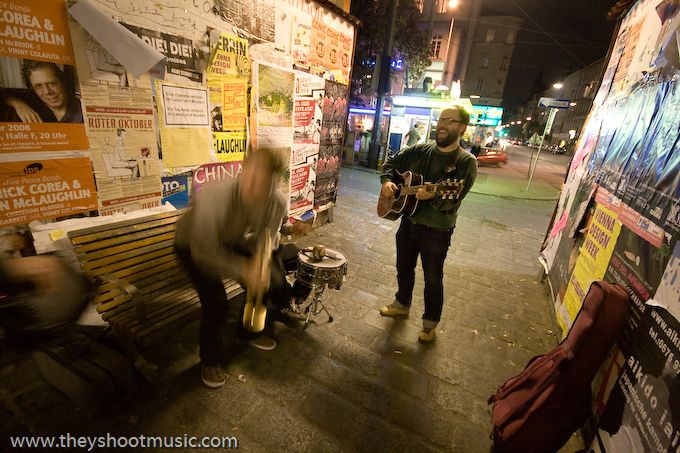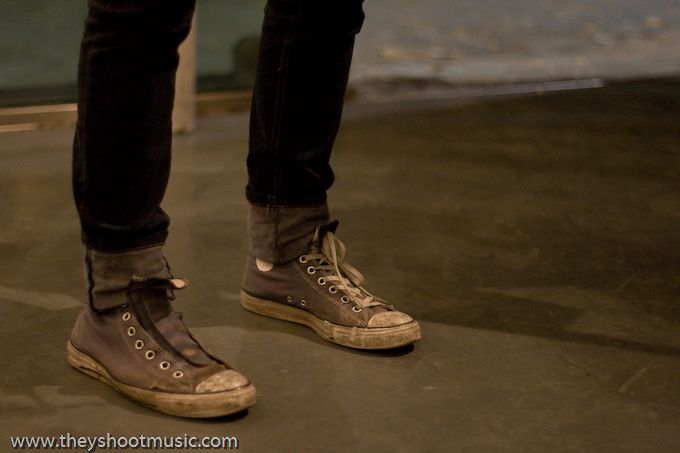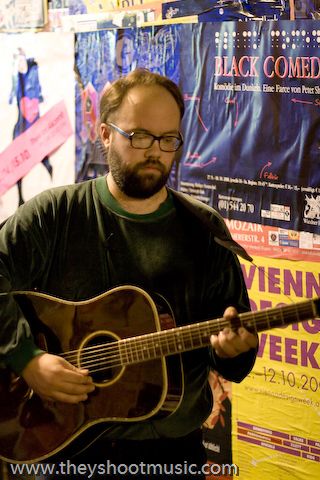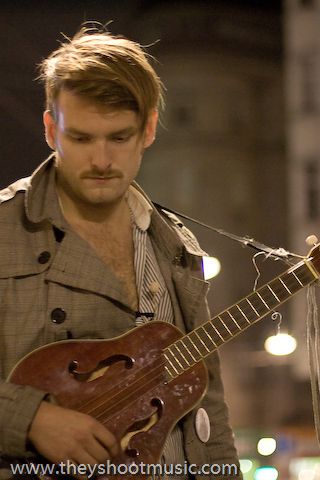Borko
Gürtel, Wienstation, 2009
It only takes a heavy guitar riff to make people turn around. As Borko played around a bit while setting up their stuff in a short alleyway, they soon attract a small crowd of Turkish men, including the operator of a kebab stand peaking in from the back. One guy takes pictures, the others talk about the unfamiliar scene of a band playing in this busy place, surrounded by cars in the back and with trains passing by above them. Just before the end of “Dingdong Kingdom” a man abruptly stops behind the band, takes off his jacket and makes an expression as if he had something in his head, some idea to interact with this whole scenery. However, when the song is finished he just takes his bag and goes off, leaving a strange feeling of incompletion. Borko mastermind Björn Kristjánsson, a music teacher in an elementary school in Reykjavik, Iceland, is up for a second song, so we spontaneously barge into a nearby art gallery together with his bandmates, where the opening of a new exhibition was taking place that evening. Few people are left in the small room, but those who remained until the end of the vernissage are unexpectedly treated with the slowly building “Spoonstabber” from Borko’s album “Celebrating Life”. Borko not only get their round of applause after their short set, but also some extra-catering in the form of remaining sandwiches from the vernissage.
- Photography
- Simon Brugner
- Artist
- Borko





Gürtel
Two circular roads around the city center provide a basic way of orientation in Vienna. The one, Ringstraße is popular and touristy, whereas the other, Gürtel (meaning belt), is dominated by heavy traffic and separates the so-called inner districts (3rd to 9th district) from the outer districts and former suburbs of Vienna (10th to 19th district). Gürtel is the colloquial name for what is officially called Wiener Gürtelstraße or B221, Austria’s most frequented state road. On its length of 13.1 kilometres, six-to-eight-lane Gürtel road encircles central Vienna on the north, west and south, passing the two main train stations Westbahnhof and Südbahnhof. Similar to the Ringstraße, the course of today’s Gürtel was used as a fortification from the 17th to the 19th century. In the 1890s the famous Art Nouveau architect Otto Wagner designed a city railway along the Gürtel, that runs partly on a viaduct and is now the trace of the underground line U6. Until the end of World War II the Gürtel was a popular residential area with short connections to the city center but also the green and spacious outskirts close-by. The picture drastically changed with the population getting motorized. Quality of life dropped as traffic exploded and the western part of the Gürtel developed into a red-light district. Besides, in an attempt to revive the area, an urban regeneration project was started in the 1990s. The Main Public Library now upgrades Urban-Loritz-Platz and numerous restaurants, pubs and music clubs like Chelsea, rhiz and B72 opened along the Lerchenfelder Gürtel in the arches of the railway viaduct, making the area – at least in the evening – well worth a visit.’
Wienstation
„Work = Art“ – that is the message that the artistgroup wienstation has written on their homepage. In the Brunnenmarktviertel, most notably along the Grundsteingasse, several exhibition spaces and galleries have opened up in recent years. Situated under the viaduct-like archway on the Gürtel, next door to the concert venue Chelsea, wienstation belongs to these non-commercial exhibition-spaces where socio-political concept-art, installations or videos are shown. The small, yet lucid and clear shaped wienstation considers itself an open space. It is not just the artistgroup exhibiting their installations; people from outside can also use the multipurpose room for concerts, lectures or performances. Having totally inhaled the concept of an open space, they need not think twice at the idea of having Borko do a spur-of-the-moment performance at their vespertine vernissage.